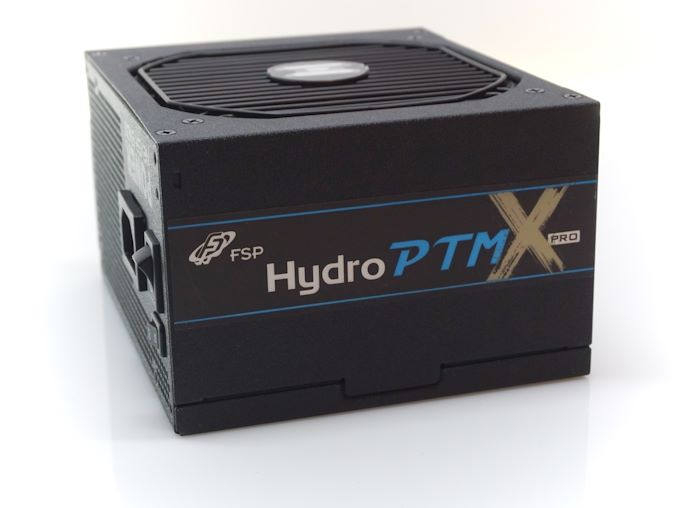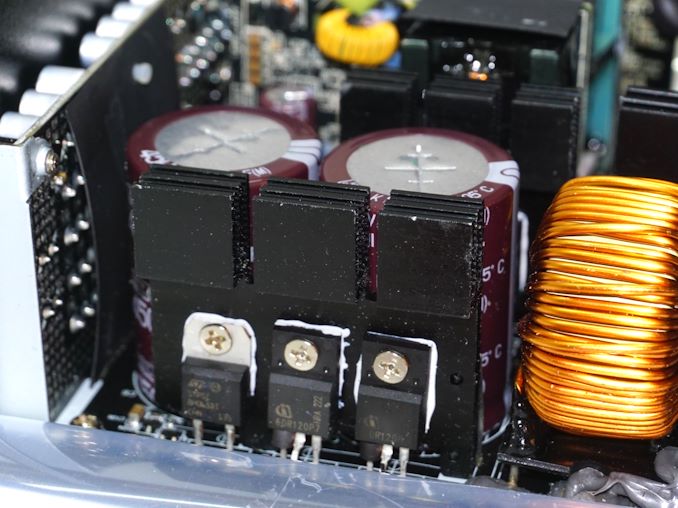The FSP Hydro PTM X Pro 1000W ATX 3.0 PSU Review: Premium Platinum Power
by E. Fylladitakis on March 7, 2023 8:00 AM EST- Posted in
- Cases/Cooling/PSUs
- PSUs
- 1000W
- FSP
- 80Plus Platinum
- ATX v3.0
- 12VHPWR
Power Supply Quality
As part of our testing, we also check output parameters are within specifications, as well as voltage ripple and line noise.
| Main Output | ||||||||
| Load (Watts) | 201.47 W | 502.71 W | 750.39 W | 999.57 W | ||||
| Load (Percent) | 20.15% | 50.27% | 75.04% | 99.96% | ||||
| Amperes | Volts | Amperes | Volts | Amperes | Volts | Amperes | Volts | |
| 3.3 V | 1.85 | 3.36 | 4.62 | 3.35 | 6.93 | 3.33 | 9.24 | 3.33 |
| 5 V | 1.85 | 5.05 | 4.62 | 5.04 | 6.93 | 5.02 | 9.24 | 5.01 |
| 12 V | 15.39 | 12.08 | 38.47 | 12.06 | 57.71 | 12 | 76.94 | 11.99 |
| Line | Regulation (20% to 100% load) |
Voltage Ripple (mV) | |||||
| 20% Load | 50% Load | 75% Load | 100% Load | CL1 12V |
CL2 3.3V + 5V |
||
| 3.3V | 0.9% | 10 | 12 | 16 | 18 | 16 | 20 |
| 5V | 0.9% | 10 | 14 | 16 | 18 | 14 | 18 |
| 12V | 0.7% | 16 | 20 | 22 | 26 | 30 | 20 |
The electrical performance of the FSP Hydro PTM X Pro 1000W PSU is excellent, even for a top-tier product. It displayed outstanding filtering, with a maximum ripple of 30 mV on the 12 V line and 16/14 mV on the 3.3V/5V lines respectively. Regulation is great as well, with the unit maintaining the regulation below 0.9% on all three of its primary power outputs.
As part of our standard testing, we test the primary protections of all PSUs we review (Over Current, Over Voltage, Over Power, and Short Circuit). The FSP Hydro PTM X Pro 1000W ATX 3.0 unit successfully passed all of the tests, generally reacting timely when needed and shutting down to protect itself and the components it is powering. The OCP and OPP protections are set a bit high, with the unit almost immediately reacting to 135% current and 128% load respectively. These protections generally tend to be slack on ATX 3.0 units due to the power excursion requirements.
Conclusion
In conclusion, the FSP Hydro PTM X Pro 1000W ATX 3.0 PSU is a unit that features a design combining reliable topologies with great quality components. The company’s engineers are using top-line active components that were essentially required to achieve its very high-efficiency ratings, as well as only Japanese capacitors from Nippon Chemi-Con that are known for their durability, ensuring that the unit can withstand heavy use and deliver consistent power.
Perhaps the most prominent feature of the Hydro PTM X Pro is its excellent electrical performance. The unit delivered outstanding energy conversion efficiency, even for an 80Plus Platinum certified unit, and can reach the certification's requirements regardless of the input voltage. Additionally, the voltage filtering and regulation are exceptional, ensuring stable power delivery to the system.
The thermal performance of the Hydro PTM X Pro is also noteworthy. The design favors reliability and low temperatures over acoustics, resulting in minimal-to-zero thermal stress. The unit’s components operate at very low temperatures, which is great for its longevity. However, the noise output of the Hydro PTM X Pro is mediocre, it's quiet at lower loads and tolerable at higher loads at room temperature, but with high noise output if both the load and the ambient temperature are high.
The Hydro PTM X Pro comes with a high MSRP price of $279, which may deter some buyers. However, we expect that the market price will decrease over time, making it a more competitive option for advanced gamers and enthusiasts. Overall, the Hydro PTM X Pro offers great performance and reliability. Despite the lack of groundbreaking features or figures, it is a solid choice for users looking for a dependable ATX 3.0 power supply unit with good all-around performance.












2 Comments
View All Comments
achinhorn - Wednesday, March 8, 2023 - link
Hey -- great article thanks. Curious why you guys don't make direct comparisons to other contending PSU's? A simple table comparing basics like cost, wattage, rating, ATX conforming, with maybe one extra column for standout differences/product novelties would be so clutch. To take it further -- why not product comparison charts in each category you test in?My main purpose for visiting this site is to be able to make informed buying decisions; currently in order to do that effectively for PSU's using Anandtech as my resource, I'd need to read every single PSU article of the past ~year, compare the individual graphs from each category for each product across articles, and compile product data. That's a tall order. For other Anantech articles covering other PC components, I can just read the latest article and see where that product lands.
Techie2 - Wednesday, March 8, 2023 - link
I'm sure the various colored stickers will be a big selling point for the intended audience. Hopefully Mommy and Daddy won't be too upset with the price. It's about 1/5th the price of a good GPU card for gamers.The high-end components are some what wasted by not using the std. ATX case size or slightly larger and a 135mm fan. Customers could have performance, efficiency and acoustics all in one PSU package.